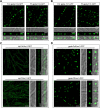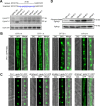Overproduction of mycotoxin biosynthetic enzymes triggers Fusarium toxisome-shaped structure formation via endoplasmic reticulum remodeling
- PMID: 38166144
- PMCID: PMC10786393
- DOI: 10.1371/journal.ppat.1011913
Overproduction of mycotoxin biosynthetic enzymes triggers Fusarium toxisome-shaped structure formation via endoplasmic reticulum remodeling
Abstract
Mycotoxin deoxynivalenol (DON) produced by the Fusarium graminearum complex is highly toxic to animal and human health. During DON synthesis, the endoplasmic reticulum (ER) of F. graminearum is intensively reorganized, from thin reticular structure to thickened spherical and crescent structure, which was referred to as "DON toxisome". However, the underlying mechanism of how the ER is reorganized into toxisome remains unknown. In this study, we discovered that overproduction of ER-localized DON biosynthetic enzyme Tri4 or Tri1, or intrinsic ER-resident membrane proteins FgHmr1 and FgCnx was sufficient to induce toxisome-shaped structure (TSS) formation under non-toxin-inducing conditions. Moreover, heterologous overexpression of Tri1 and Tri4 proteins in non-DON-producing fungi F. oxysporum f. sp. lycopersici and F. fujikuroi also led to TSS formation. In addition, we found that the high osmolarity glycerol (HOG), but not the unfolded protein response (UPR) signaling pathway was involved in the assembly of ER into TSS. By using toxisome as a biomarker, we screened and identified a novel chemical which exhibited high inhibitory activity against toxisome formation and DON biosynthesis, and inhibited Fusarium growth species-specifically. Taken together, this study demonstrated that the essence of ER remodeling into toxisome structure is a response to the overproduction of ER-localized DON biosynthetic enzymes, providing a novel pathway for management of mycotoxin contamination.
Copyright: © 2024 Wang et al. This is an open access article distributed under the terms of the Creative Commons Attribution License, which permits unrestricted use, distribution, and reproduction in any medium, provided the original author and source are credited.
Conflict of interest statement
The authors have declared that no competing interests exist.
Figures







Similar articles
-
Capping proteins regulate fungal development, DON-toxisome formation and virulence in Fusarium graminearum.Mol Plant Pathol. 2020 Feb;21(2):173-187. doi: 10.1111/mpp.12887. Epub 2019 Nov 6. Mol Plant Pathol. 2020. PMID: 31693278 Free PMC article.
-
Endoplasmic reticulum-mitochondrial encounter structure regulates the mitochondrial morphology, DON biosynthesis and toxisome formation in Fusarium graminearum.Microbiol Res. 2024 Dec;289:127892. doi: 10.1016/j.micres.2024.127892. Epub 2024 Sep 3. Microbiol Res. 2024. PMID: 39255584
-
The fungal myosin I is essential for Fusarium toxisome formation.PLoS Pathog. 2018 Jan 22;14(1):e1006827. doi: 10.1371/journal.ppat.1006827. eCollection 2018 Jan. PLoS Pathog. 2018. PMID: 29357387 Free PMC article.
-
Fusarium graminearum Trichothecene Mycotoxins: Biosynthesis, Regulation, and Management.Annu Rev Phytopathol. 2019 Aug 25;57:15-39. doi: 10.1146/annurev-phyto-082718-100318. Epub 2019 Mar 20. Annu Rev Phytopathol. 2019. PMID: 30893009 Review.
-
Biological detoxification of the mycotoxin deoxynivalenol and its use in genetically engineered crops and feed additives.Appl Microbiol Biotechnol. 2011 Aug;91(3):491-504. doi: 10.1007/s00253-011-3401-5. Epub 2011 Jun 21. Appl Microbiol Biotechnol. 2011. PMID: 21691789 Free PMC article. Review.
Cited by
-
The Endoplasmic Reticulum Membrane Protein Complex Is Important for Deoxynivalenol Production and the Virulence of Fusarium graminearum.J Fungi (Basel). 2025 Jan 31;11(2):108. doi: 10.3390/jof11020108. J Fungi (Basel). 2025. PMID: 39997402 Free PMC article.
References
MeSH terms
Substances
LinkOut - more resources
Full Text Sources

